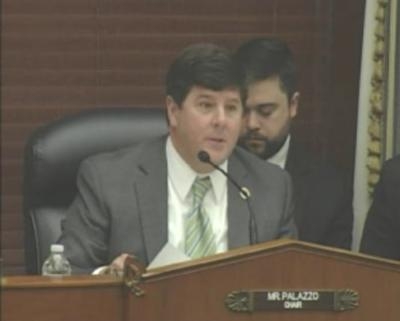Tue, Mar 03, 2015
Remarks Came During Hearing To Review NASA's Efforts To Launch Astronauts To ISS From U.S. Soil
The Subcommittee on Space on Friday held a hearing on The Commercial Crew Program: Challenges and Opportunities. The purpose of the hearing was to review NASA’s efforts to develop and acquire safe, reliable, and affordable crew transfer services to the International Space Station (ISS).

“Previous testimony before this Committee indicated that the taxpayer will fund roughly 90 percent of the development of these capabilities and then in-turn pay once again for the services derived from those capabilities," said Subcommittee Chairman Steven Palazzo (R-MS) (pictured). "In total, NASA has spent, or plans to spend, over $8 billion on this initiative, which I believe represents a necessary investment if managed effectively. In order to protect taxpayer interests, however, this level of investment by the taxpayer requires a similar level of transparency and accountability.
“Denying information to ASAP, or Congress, about the Commercial Crew Program is unacceptable when the hardworking American taxpayers are footing the bill for the program and the safety of our astronauts is on the line. Congress and the American people deserve to have answers to the questions posed by ASAP. I am pleased to hear that NASA is now being more open and I hope this trend continues.”
“American astronauts personify our nation’s pioneering spirit. They represent our leadership as explorers and agents of discovery," said full committee chair Lamar Smith (R-TX). "A great deal of trust has been placed in the commercial crew partners – Boeing and SpaceX - that are partnering with NASA to take our astronauts into space. This is an extraordinary responsibility for these companies. It is one that cannot be taken lightly.
“It is absolutely imperative that we understand the gravity of what it means to carry our astronauts into space. This committee will continue to monitor whether the Commercial Crew Program will ensure safety while also respecting cost and schedule constraints. We can only do this if NASA is open and transparent about the program.”
The Commercial Crew program was created in 2010 as a NASA partnership in which private contractors will carry U.S. astronauts to and from the ISS. Currently, we pay more than $70 million per astronaut per flight to maintain a U.S. presence on ISS. The final phase of the Commercial Crew program offers the first opportunity for commercial space companies to carry U.S. astronauts to the ISS. After initial phases with several other companies, Boeing and SpaceX were selected to continue with contracts for final development, including certification.
Vice Admiral Joseph Dyer, Chairman of the Aerospace Safety Advisory Panel (ASAP) participated in the hearing. The ASAP reports annually to Congress and the NASA Administrator on the safety of NASA’s programs and recently criticized the Commercial Crew program for “lack of transparency” and complained about “barriers to sharing information related to certification and safety.”
Also participating in the hearing were Mr. Bill Gerstenmaier, Associate Administrator for NASA’s Human Exploration and Operations Mission Directorate, Mr. John Mulholland, Vice President and Program Manager of Commercial Programs at Boeing, and Dr. Garrett Reisman, Director of Crew Operations for Space Exploration Technologies Corporation.
More News
Execute Missed Approach Instructions issued to a pilot making an instrument approach which means continue inbound to the missed approach point and execute the missed approach proce>[...]
Aero Linx: British Helicopter Association (BHA) The BHA promotes the compliant, safe and considerate use of rotorcraft throughout the UK. Its activities are directed by a Council o>[...]
During An Aerial Application Flight, The Engine Lost Power And The Airplane Began To Descend Analysis: The pilot reported that, during an aerial application flight, the engine lost>[...]
Also: AMA Names Tyler Dobbs, More Falcon 9 Ops, Firefly Launch Unsuccessful, Autonomous F-16s The Air Force has begun ground testing a future uncrewed jet design in a milestone tow>[...]
Aero Linx: HeliOffshore HeliOffshore is the global, safety-focused association for the offshore helicopter industry. Our mission is to lead a collective safety conversation, identi>[...]
 ANN's Daily Aero-Term (05.12.25): Execute Missed Approach
ANN's Daily Aero-Term (05.12.25): Execute Missed Approach ANN's Daily Aero-Linx (05.12.25)
ANN's Daily Aero-Linx (05.12.25) NTSB Final Report: Piper PA-36-375
NTSB Final Report: Piper PA-36-375 Airborne-NextGen 05.06.25: AF Uncrewed Fighters, Drones v Planes, Joby Crew Test
Airborne-NextGen 05.06.25: AF Uncrewed Fighters, Drones v Planes, Joby Crew Test ANN's Daily Aero-Linx (05.13.25)
ANN's Daily Aero-Linx (05.13.25)



